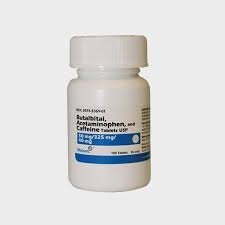Introduction to Butalbital
Butalbital is a barbiturate commonly utilized in the symptomatic treatment of tension-type headaches, which are characterized by dull, aching pain and muscle tightness in the head and neck. Being a member of the barbiturate class, butalbital offers sedative and muscle-relaxing properties, making it effective in alleviating the discomfort associated with such headaches. Its pharmacological classification places it alongside other central nervous system depressants, but its unique properties have made it a cornerstone in headache management.
The mechanism of action of butalbital involves its ability to enhance the activity of gamma-aminobutyric acid (GABA), a neurotransmitter that inhibits neural activity. By amplifying GABA’s effects, butalbital can reduce the excitability of neurons, leading to a calming effect on the central nervous system. This sedative action contributes to the reduction of muscle tension and pain perception, providing symptomatic relief for those suffering from tension-type headaches.
Butalbital’s clinical applications are not limited to tension-type headaches; it is often found in combination with other medications to broaden its efficacy. For instance, it is frequently paired with acetaminophen or aspirin, and sometimes caffeine, to create multi-ingredient treatments that address various aspects of headache pathology. These combinations can offer anti-inflammatory benefits, analgesic effects, and enhanced absorption of the drug, thereby improving overall headache management.
Historically, butalbital has been developed and refined over decades to better suit the needs of patients experiencing chronic headaches. Its establishment as a primary treatment option is reflective of continuous research and clinical trials demonstrating its efficacy and safety. As a result, butalbital remains a vital component in the therapeutic arsenal against tension-type headaches, providing much-needed relief to countless individuals.
Combinations with Butalbital: Synergistic Effects
Butalbital is frequently formulated with other compounds, such as acetaminophen, aspirin, caffeine, and codeine, to enhance its therapeutic efficacy in treating tension-type headaches. Combining butalbital with these agents augments its analgesic and muscle relaxant effects, leveraging each component’s unique pharmacological properties to provide comprehensive relief.
Acetaminophen, a commonly used analgesic and antipyretic, works by inhibiting the synthesis of prostaglandins in the central nervous system, thus reducing pain and fever. When used in conjunction with butalbital, acetaminophen’s straightforward pain-relief mechanism complements butalbital’s sedative properties, collectively mitigating tension headaches more effectively than either agent alone.
Aspirin, a non-steroidal anti-inflammatory drug (NSAID), adds an anti-inflammatory dimension to the combination. By decreasing inflammation, preventing platelet aggregation, and offering analgesic benefits, aspirin works synergistically with butalbital, addressing both the pain and underlying inflammatory components of tension-type headaches.
Caffeine, a central nervous system stimulant, is another frequent partner in butalbital formulations. It acts by antagonizing adenosine receptors, thus increasing neuronal activity. This stimulant effect can offset the sedative properties of butalbital, reducing drowsiness while simultaneously enhancing pain relief. Furthermore, caffeine has been found to enhance the absorption and efficacy of other analgesics, such as acetaminophen and aspirin, making it a valuable inclusion.
Codeine, an opioid analgesic, is occasionally combined with butalbital for its potent pain-relieving capabilities. Through its conversion to morphine via cytochrome P450 enzymes in the liver, codeine binds to opioid receptors, dulling the sensation of pain. However, combinations containing codeine are generally reserved for more severe cases due to the risk of dependency and side effects.
In essence, these multi-ingredient formulations employ a holistic approach to headache management, combining agents that tackle pain through various pathways. Each component is selected to complement butalbital’s muscle relaxant and sedative properties, offering a multifaceted assault on the mechanisms of tension-type headaches. This synergy ultimately contributes to a more comprehensive and effective therapeutic outcome for patients.
Efficacy and Clinical Trials
The effectiveness of butalbital, whether utilized as a standalone medication or in combination with other drugs, has been a significant focus of clinical trials and research studies. Various investigations have evaluated the capability of butalbital to alleviate the symptoms of tension-type headaches—a prevalent form of headache impacting millions globally.
Clinical trials have demonstrated mixed results regarding the efficacy of butalbital. For instance, a study published in the “Journal of Headache and Pain” found that a combination formula containing butalbital, acetaminophen, and caffeine provided superior pain relief compared to a placebo. Patients reported substantial improvements in headache intensity and duration, lending support to the therapeutic value of butalbital-based combinations.
Conversely, studies such as those documented in “The Journal of Clinical Pharmacology” raise concerns about the potential for over-reliance and dependency associated with butalbital-containing compounds. The risk-versus-reward profile is often evaluated considering both efficacy and the potential for abuse.
Moreover, real-world evidence collected through patient testimonials also underscores the variable efficacy of butalbital. Some patients have lauded its ability to provide prompt relief from debilitating headache symptoms, enhancing their quality of life. Others, however, have reported limited benefits and concerns regarding side effects such as drowsiness, dizziness, and cognitive impairments.
A meta-analysis of various trials aggregated in the “European Journal of Neurology” indicated that while butalbital is effective, its efficacy should be compared cautiously with other alternatives like nonsteroidal anti-inflammatory drugs (NSAIDs) and triptans, which may offer comparable relief with a better side effect profile.
In conclusion, while clinical trials and patient testimonials present a nuanced view of butalbital’s efficacy, ongoing research and a careful assessment of individual patient needs remain crucial. The potential for dependency and adverse effects continues to spur debate among healthcare professionals regarding its optimal use in treating tension-type headaches.
Safety, Side Effects, and Considerations
Butalbital is frequently prescribed for the treatment of tension-type headaches due to its efficacy in inducing relaxation and alleviating pain. However, its use is not devoid of risks and potential side effects. A comprehensive understanding of the safety profile of butalbital, along with its combinations, is paramount for both prescribers and patients.
One of the most critical considerations associated with butalbital is its potential for dependency. Prolonged use of butalbital can lead to physical and psychological dependence, necessitating careful monitoring by healthcare providers. Patients may experience withdrawal symptoms, characterized by agitation, nausea, muscle cramps, and even seizures, upon abrupt discontinuation of the drug. Therefore, a gradual tapering off is recommended under medical supervision.
Common side effects of butalbital include dizziness, drowsiness, and sedation, which can affect daily functioning and activities that require alertness. Gastrointestinal issues such as nausea and vomiting are also relatively frequent. In some cases, patients may experience allergic reactions manifesting as rash, itching, or swelling, necessitating immediate medical attention.
Less common but more severe side effects include significant drops in blood pressure, respiratory depression, and liver toxicity, particularly when butalbital is combined with acetaminophen. Long-term use elevates the risk of developing tolerance, leading to an increased dosage requirement to achieve the same therapeutic effect, further complicating the management of headache disorders.
Patients must be educated about the contraindications associated with butalbital. Individuals with a history of substance abuse, certain mental health disorders, or respiratory illnesses should avoid butalbital due to the heightened risk of adverse effects. Pregnant or breastfeeding women are also advised against using it, as it can cross the placenta and enter breast milk, posing significant risks to the fetus or infant.
Guidelines for safe use stress the importance of adhering to prescribed dosages and frequency. Alternating butalbital with non-barbiturate-based treatments may also be advisable to mitigate risks. For patients unsuitable for butalbital therapy, alternatives such as non-prescription pain relievers, muscle relaxants, and lifestyle interventions like stress management techniques and physical therapy may be considered.
Ultimately, a balanced view of butalbital’s benefits and risks ensures that patients are well-informed, enabling them to make educated decisions in collaboration with their healthcare providers.






Reviews
There are no reviews yet.